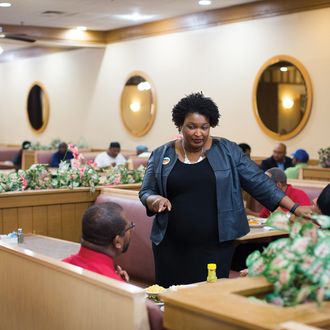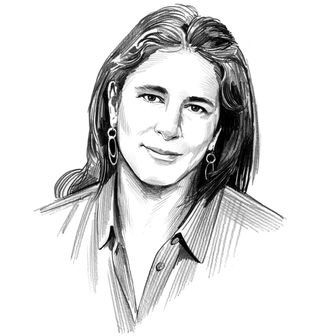
The Tuesday party for Jon Ossoff in Georgia’s Sixth Congressional District was hopping long after Ossoff had given his concession speech. While many pundits were diagnosing the Democrat’s loss to Republican Karen Handel as a defeat of America’s burgeoning resistance movement, some of the most die-hard members of that resistance — who had just spent months working their, uh, osses off — did not appear despondent.
After the race had been called and Ossoff had addressed the crowd, the Westin hotel didn’t empty. Many supporters kept dancing and pouring Champagne. Some were hoping to say hello to Georgia’s House minority leader and gubernatorial candidate Stacey Abrams, who was also lingering; others were already planning their next moves forward into what they felt, even if the national media did not, was Georgia’s potentially bright progressive future.
In the days that followed Ossoff’s defeat, the political press would engage in panicky postmortems: Was the close result a harbinger of progressive possibility or marker of futility? Must the Democratic Party purge its most frequently demonized leaders (i.e., non–white guys, like Nancy Pelosi) or its redistributionist priorities (which white moderates may reject as disproportionately benefiting people of color) to win moderates? Will voters of color ever turn out as they did for Barack Obama?
It is all part of an ancient debate in electoral politics, referred to reductively as “persuasion versus mobilization”: Should Democrats work to persuade reliable voters, many of them centrists, to vote by evincing a bland ideological flexibility designed not to alienate, or should they reach out to more unlikely voters in an effort to grow a base that could support a more progressive slate of policies? On Voting Day, these old electoral calculations were being run by some of Ossoff’s volunteer organizers, many of them political neophytes.
“The fact that we came this close in a place that’s not nearly as primed for Democratic takeover as the rest of the state,” said Essence Johnson, a business consultant and member of the local chapter of Indivisible, a nationwide web of resistance groups, “means that if we are more intentional in the future about talking to [new] people, then there’s a path to victory. But it’s a value statement: wanting to engage people who nobody engages.”
Ossoff’s four-point loss was a big swing from November, when the district elected Republican Tom Price by a 23-point margin (though came within two points of voting for Hillary Clinton). It’s quite a shift but ultimately insufficient, and attributable in part to the fact that Democrats had, until now, largely given up on blood-red districts.
Ossoff missed his majority — and an outright win — in April by a mere 3,700 votes, and some activists suggest that more energetic targeting of marginalized voters in the district could have pushed him over then. If the Democratic Party wants to close the newly narrowed partisan gap, this argument goes, it must expand its reach not just to wavering moderates disgusted by Trump but to those who have long felt left behind by electoral politics, some of whom did come out to elect Barack Obama: young people; black, Asian, and Latino voters; the economically vulnerable.
Naturally, generations of Democratic candidates have vowed to draw new voters to the polls. But perhaps precisely because Ossoff’s bid drew a phalanx of dedicated volunteers who are new to politics and thus unburdened by past disillusionment, their curiosity about why the campaign targeted some communities more insistently than others led them to fresh approaches. After knocking repeatedly on the same doors — of voters identified as reliable — canvassers began to consider how to reach the people behind other doors.
The guerrilla efforts of newly awakened locals — many of them middle-class suburban women — included registration drives at stores in predominantly Latino neighborhoods, canvassing apartments where residents were more likely to be people of color, and deputizing recent high-school graduates to spread the word via social media. These were efforts outside the purview of the campaign. “We didn’t have an instruction manual,” said Essence Johnson. “It was just: Let’s reach people.”
Based on the earlier round and some early voting numbers, it seems that Asian-American turnout for Ossoff was higher than many expected, in part because of in-language canvassing and phone-banking undertaken by a group dedicated to reaching them, but African-Americans did not vote in numbers as high as they might have.
Stacey Abrams, the gubernatorial candidate, acknowledged that. But she argued that the district’s big swing “is not purely attributable to Republicans or to women,” but also to communities of color. Of course, black voters have been the backbone of southern Democratic politics for years, and black churches have served as one of the strongest institutional frameworks available to Democratic candidates since the collapse of unions. But there’s a difference between targeting reliable black voters and making a play for those who have no history of electoral participation.
In 2013, Abrams founded the nonpartisan New Georgia Project, with the aim of registering 800,000 Georgia voters by 2024, specifically what the groups refer to as “the New American Majority” — people of color, 18-to-29-year-olds, and unmarried women. The daughter of two Methodist ministers, Abrams has served in the Georgia House since 2007, becoming the first woman ever to lead either party in the state legislature. Nina Turner, a former Ohio state senator and Bernie Sanders surrogate, spoke at Abrams’s Atlanta campaign launch and said of her outreach work, “She actually went after people who were just out in limbo. That really is the model … to get forgotten people. And she’s not just going for people of color; she’s going and getting some of our white sisters and brothers who’ve been left behind.”
Abrams sees mobilization itself as requiring its own kind of persuasion: persuading people who have no faith in politics to participate in it, breaking a vicious cycle. “If you’re not already a regular voter in Georgia,” said Abrams, “you’re not likely to be contacted by a campaign, and if you’re not contacted by a campaign, you’re not likely to become a regular voter.”
Georgia, a state that is getting younger and less white every year, like others in the Sun Belt and the West, is fertile ground for this approach, Abrams believes. After the Republican wave of 2010, she said, state Democrats “had to claw back at least four Republican seats to hold off a supermajority, by focusing on voters that Republicans assumed wouldn’t vote,” which they did in part by running candidates like Sam Park, the first openly gay man and first Asian-American Democrat elected to the state legislature, who did just the kind of targeted outreach Abrams advocates for.
Still, mobilization of first-time voters is difficult and expensive. These ignored communities may be rich with potential voters, but they are also populated by people who have every reason to distrust politicians as well as anyone who wants to put them on a list. Kat Calvin, whose new organization Spread the Vote helps people obtain voter ID, found quickly that “if you knock on the doors of marginalized people and ask them about their ID situation, they slam the door.” Even once voters are registered, they cannot necessarily vote, especially in states like Georgia where voter-ID laws effectively target students, the poor, and communities of color.
And candidates who might especially appeal to or represent underserved communities are often viewed as electoral risks. Abrams herself is an example of that risk: If she wins her primary against her House colleague Stacey Evans and then the general election, she would be the first black woman in the U.S. ever elected governor.
Perhaps it’s true, as some older party wags have guessed, that grassroots interest in mobilization is born in part of political naïveté: Organizers who’ve been activated in the wake of Donald Trump’s election haven’t yet absorbed how daunting the project will be.
“But if we don’t do it,” argued Abrams, “we will never win.” What’s more, she believes, it is a moral imperative. “Those communities, when left out and left behind, don’t cease to be a part of our state.”
*This article appears in the June 26, 2017, issue of New York Magazine.






























